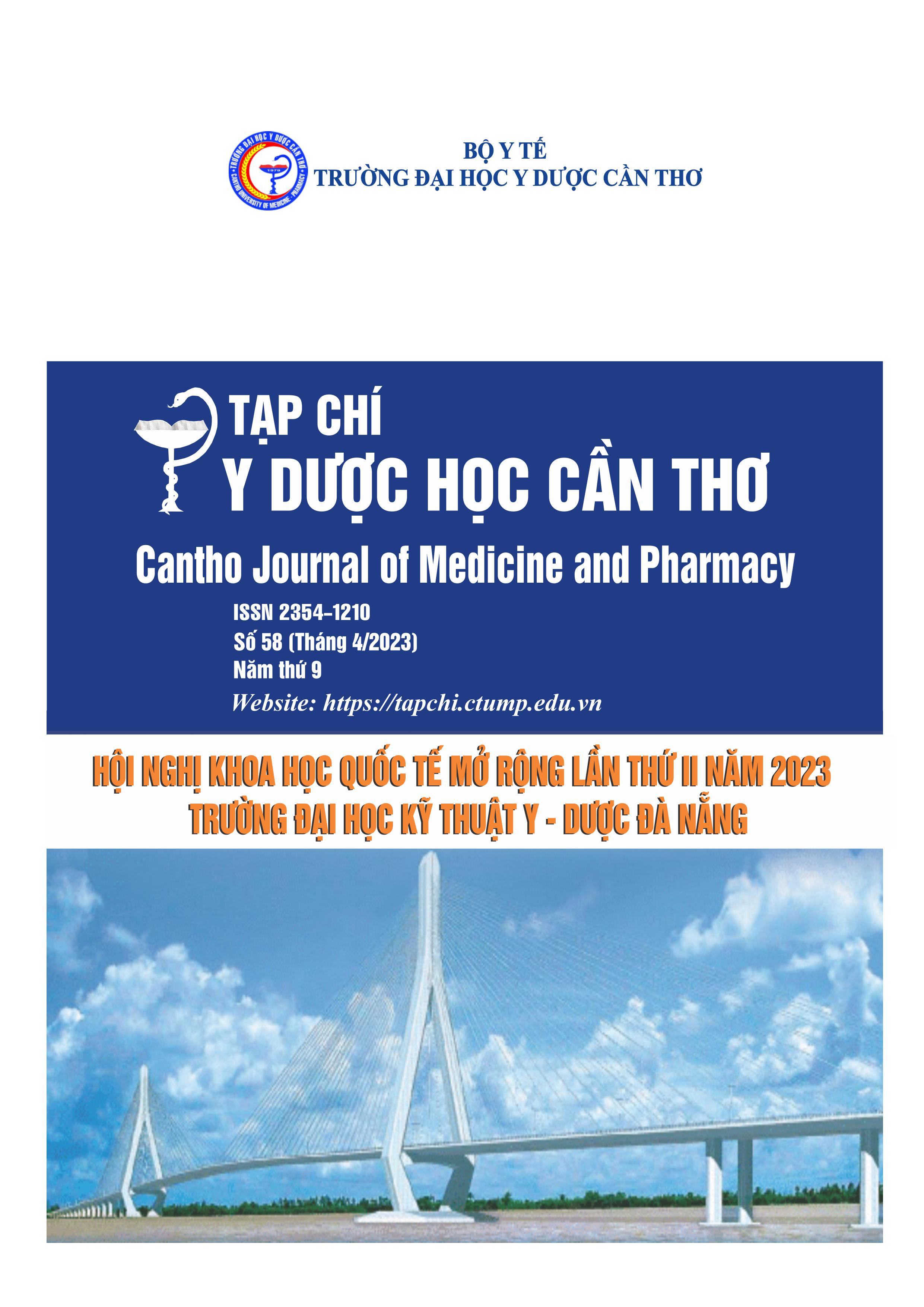PATHOGENIC CHARACTERISTICS AND ANTIBIOTIC RESISTANCE OF PSEUDOMONAS AERUGINOSA STRAINTS AT DA NANG C HOSPITAL
Main Article Content
Abstract
Background: P.aeruginosa is one of the causative agents of severe multi-organ infections. Bacteria have diverse resistance mechanisms, so they tend to be resistant to many different antibiotic strains, thus causing many difficulties in treatment. Objective: Investigation of pathogenic characteristics and antibiotic resistance of P.aeruginosa at Da Nang C Hospital. Materials and method: A cross-sectional study on 43 strains of P.aeruginosa isolated from sputum, bronchial fluid, blood, urine, and pus at Hospital C Da Nang. Determination of antibiotic resistance of P.aeruginosa strains by Kirby-Bauer method. Classification of the degree of multi-antibiotic resistance of bacteria causing infections was performed according to Magiorakos et al. Results: Ratio of P.aeruginosa causing infection in men and women was 62.8%, and 32.7%. P.aeruginosa infections mainly in elderly patients aged 60 years and older, accounting for 83,7%. The most isolated strains of P.aeruginosa were found in the Intensive Care Unit (41.9%), the Department of Respiratory Medicine (18.6%), the Department of Internal Medicine Geriatrics (13.9%), the Department of General Surgery (9.3%), Neuro-Trauma Surgery (9.3%) and the lowest in the Department Renal Internal (7%). The highest form of clinical infection caused by P. aeruginosa is respiratory infection (60.5%), followed by urinary tract infection (16.3%), wound infection (9.3%), surgical site infection (2.3%), ulcer infection (9.3%) and blood infection (2.3%). P.aeruginosa was isolated from sputum (51.2%), pus (20.9%), urine (16.3%), bronchial fluid (9.3%) and at least in blood (2.3%). P.aeruginosa has low resistance to Colistin, Piperacillin/Tazobactam, Amikacin with the rate of 16.3%, respectively; 11.6%; 32.6%, resistance ranges from 40-60% to antibiotics: Torbramycin and Gentamycin (44.2%), Cefepime (46.5%), Ciprofloxacin (53.5%), Meropenem (44.2). %), Imipenem (41.9%), Levofloxacin (55.8%), Ofloxacin (58.1%). There were 23.3% multiresistant P.aeruginosa, 30.2% extended resistance and no fully resistant strains. Conclusions: P.aeruginosa causes infections mainly in males and in elderly patients. Respiratory infection is the most common form of infection caused by P. aeruginosa. The most isolated samples of P.aeruginosa were sputum, followed by pus and urine. Bacteria are relatively resistant from 40-60% to the antibiotics Ciprofloxacin, Meropenem, Imipenem, Levofloxacin, Ofloxacin. There were 23.3% multi-resistant P.aeruginosa strains, 30.2% extended resistance strains and no all-resistant strains.
Article Details
Keywords
Pseudomonas aeruginosa, antibiotic resistance, Da Nang C Hospital
References
2. Vũ Thị Thu Hiền (2018), “Nghiên cứu đặc tính kháng kháng sinh và mối liên hệ kiểu gen của các chủng Pseudomonas aeruginosa phân lập tại Bệnh viện Việt Đức”, Tạp chí Khoa học và Công nghệ Việt Nam, 12, tr. 14-17.
3. Hoàng Thị Minh Hòa, Nguyễn Thị Xuyên và cộng sự (2020), “Nghiên cứu tính kháng kháng sinh của các chủng trực khuẩn Gram âm gây bệnh thường gặp phân lập được tại Bệnh viện Đa khoa vùng Tây Nguyên”, Tạp chí Y học cộng đồng, 2(55), tr.36-41.
4. Hà Thị Bích Ngọc và cộng sự (2019), “Tình hình kháng sinh của vi khuẩn Gram âm thường gặp phân lập từ bệnh nhân điều trị tại Bệnh viện Hữu nghị Việt Tiệp, Hải Phòng”, Tạp chí Y học dự phòng, 29(21), tr. 131.
5. Trần Ngọc (2018), Nghiên cứu tình hình sử dụng kháng sinh trong điều trị nhiễm khuẩn bệnh viện tại khoa Hồi sức tích cực – chống độc ở Bệnh viện Đa khoa Tây Ninh, Luận văn Thạc sĩ Dược học, Hà Nội.
6. Võ Thị Kiều Vân, Nghiêm Thị Thanh Vân (2019), “Khảo sát mức độ đề kháng kháng sinh của Acinetobacter baumannii và Pseudomonas aeruginosa được phân lập tại Bệnh viện Đồng Nai sáu tháng đầu năm 2018”, Tạp chí Y học lâm sàng.
7. Abbas SH, Naeem M, et al. (2015), “Sensitivity patterns of Pseudomonas aeruginosa isolates obtained from clinical specimens in Peshawar”, J Ayub Med Coll Abbottabad, 27(2), pp.329332.
8. Abdul Samad, et al. (2017), “Antimicrobial susceptibility patterns of clinical isolates of Pseudomonas aeruginosa isolated from patients of respiratory tract infections in a Tertiary Care Hospital, Peshawa”, Pak J Med Sci, 33(3), pp. 670-674.
9. Gill JS, et al. (2016), “Prevalence of Multidrug-resistant, Extensively Drug-resistant, and
Pandrug-resistant Pseudomonas aeruginosa from a Tertiary Level Intensive Care Unit”, Journal of Global Infectious Diseases, 8(4), pp. 155-159.
10. Magiorakos, Srinivasan, et al. (2012), “Multidrug-resistant, extensively drug-resistant and pandrug-resistant bacteria: an international expert proposal for interim standard definitions for acquired resistance", Clin Microbiol Infect, 18(3), pp. 268-281.
11. S. Sharma and P. Srivastava (2016), “Resistance of antimicrobial in Pseudomonas aeruginosa”, Int. J. Curr. Microbiol. Appl. Sci, 5(3), pp.121-128.


